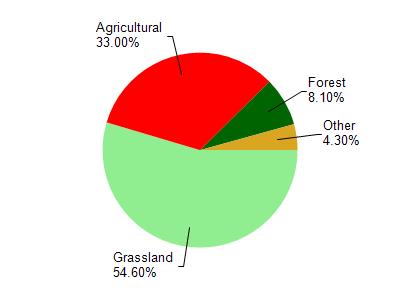Iowa
Yes
No
No
Fish and Aquatic Life
Overview
This small stream serves as a tributary to Brewery Creek. A baseline survey conducted in 2000 and a sportfish survey conducted in 2001 confirmed this stream’s status as a Class II trout stream (Sims). Both brown and brook trout were found in the surveys. With its fairly high gradient, the fish manager feels this stream has the potential as a Class I trout stream. Although impacted by agricultural non-point runoff, the water quality appears to be improving as the stream continues to run clear even after rains (Sims).
Date 2002
Author Aquatic Biologist
Historical Description
Rock Branch - Mouth location T4N R3E Section 18 -13, Surface area = 4.0 acres, Length = 4.0 miles, Gradient = 57.5 feet per mile, Total alkalinity = 282.0 mg/l, Volume of flow = 3.0 cfs.
Rock Branch begins as warmwater seepage stream on a north-south ridge which extends from Dodgeville into Lafayette County. As the stream progresses, springs become its principal water source. It meets with Brewery Creek about two miles south of Mineral Point and is called Furnace Creek thereafter. Its basin is subject to fluctuating water levels which result in heavy bank erosion. This is brought about mostly because of its steep gradient and about 92 percent of' its watershed is cleared for beef cattle grazing and crops.
Its sport fishery consists mainly of brown trout with some smallmouth bass near the mouth. Brook trout have been known to inhabit its water in the past but it is doubtful if any exist today. Brown trout are stocked annually to maintain the fishery. Forage fish species present include white and hogsuckers; bluntnose and stoneroller minnows; hornyhead and creek chubs; redbelly dace, johnny darters, and brook sticklebacks. Aquatic game assets are limited to some muskrats near the mouth.
There are no public lands on the stream but some fishing easements on the best trout water are desirable. Presently, it is accessible from five road crossings.
From: Piening, Ronald and Threinen, C.W., 1968. Lake and Stream Classification Project. Surface Water Resources of Iowa County, Wisconsin Department of Natural Resources, Madison, WI.
Date 1968
Author Surface Water Inventory Of Wisconsin
General Condition
Rock Branch (miles 0-2.96) was assessed during the 2018 listing cycle; new biological (fish Index of Biotic Integrity (IBI) scores) sample data were clearly below the 2018 WisCALM listing thresholds for the Fish and Aquatic Life use. This water was meeting this designated use and was not considered impaired.
Date 2017
Author Ashley Beranek
Condition
Wisconsin has over 84,000 miles of streams, 15,000 lakes and milllions of acres of wetlands. Assessing the condition of this vast amount of water is challenging. The state's water monitoring program uses a media-based, cross-program approach to analyze water condition. An updated monitoring strategy (2015-2020) is now available. Compliance with Clean Water Act fishable, swimmable standards are located in the Executive Summary of Water Condition in 2018. See also the 'monitoring and projects' tab.
Reports
Recommendations
Fish Management, Access
Fisheries management should determine the reason for lack of trout returns in the Rock Branch to determine if it is practical to continue stocking efforts.
Management Goals
Wisconsin's Water Quality Standards provide qualitative and quantitative goals for waters that are protective of Fishable, Swimmable conditions [Learn more]. Waters that do not meet water quality standards are considered impaired and restoration actions are planned and carried out until the water is once again fishable and swimmable
Management goals can include creation or implementation of a Total Maximum Daily Load analysis, a Nine Key Element Plan, or other restoration work, education and outreach and more. If specific recommendations exist for this water, they will be displayed below online.
Monitoring
Monitoring the condition of a river, stream, or lake includes gathering physical, chemical, biological, and habitat data. Comprehensive studies often gather all these parameters in great detail, while lighter assessment events will involve sampling physical, chemical and biological data such as macroinvertebrates. Aquatic macroinvertebrates and fish communities integrate watershed or catchment condition, providing great insight into overall ecosystem health. Chemical and habitat parameters tell researchers more about human induced problems including contaminated runoff, point source dischargers, or habitat issues that foster or limit the potential of aquatic communities to thrive in a given area. Wisconsin's Water Monitoring Strategy was recenty updated.
Grants and Management Projects
Monitoring Projects
| WBIC | Official Waterbody Name | Station ID | Station Name | Earliest Fieldwork Date | Latest Fieldwork Date | View Station | View Data |
|---|
| 928200 | Rock Br | 10054252 | Rock Br US Brecken Rd | | | Map | Data |
| 928200 | Rock Br | 10008041 | Rock Branch Station 3 | | | Map | Data |
| 928200 | Rock Br | 10008040 | Rock Branch Station 2 | | | Map | Data |
| 928200 | Rock Br | 253041 | Rock Branch at Cth Dd | 4/5/2000 | 11/6/2000 | Map | Data |
|

Watershed Characteristics
Rock Br is located in the Mineral Point and Sudan Branches watershed which is 108.26 mi². Land use in the watershed is primarily grassland (54.60%), agricultural (33%) and a mix of forest (8.10%) and other uses (4.30%). This watershed has 289.93 stream miles, 87.79 lake acres and 699.78 wetland acres.
Nonpoint Source Characteristics
This watershed is ranked Not Ranked for runoff impacts on streams, Not Ranked for runoff impacts on lakes and High for runoff impacts on groundwater and therefore has an overall rank of High. This value can be used in ranking the watershed or individual waterbodies for grant funding under state and county programs.However, all waters are affected by diffuse pollutant sources regardless of initial water quality. Applications for specific runoff projects under state or county grant programs may be pursued. For more information, go to surface water program grants.